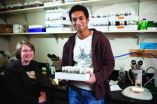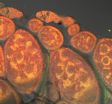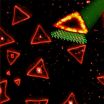(Press-News.org) ANN ARBOR—Many medically minded researchers are in hot pursuit of designs that will allow drug-carrying nanoparticles to navigate tissues and the interiors of cells, but University of Michigan engineers have discovered that these particles have another hurdle to overcome: escaping the bloodstream.
Drug delivery systems promise precision targeting of diseased tissue, meaning that medicines could be more effective at lower doses and with fewer side effects. Such an approach could treat plaques in arteries, which can lead to heart attacks or strokes.
Drug carriers would identify inflamed vessel walls and deliver a drug that removes the deposits of calcium, cholesterol and other substances. Or, the carriers might seek out markers of cancer and kill off the small blood vessels in tumors, starving the malignant tissue of food and oxygen.
Nanoparticles, which have diameters under one micron, or one-thousandth of a millimeter, are thought to be the most promising drug carriers. Omolola Eniola-Adefeso, U-M professor of chemical engineering who studies nanoparticles in flowing blood, says the immune system can't get rid of them quickly.
"It's hard for a white blood cell to understand it has a nanoparticle next to it," she said.
Those same tiny dimensions allow them to slip through the cracks between cells and infiltrate cell membranes, where they can go to work administering medicine. But Eniola-Adefeso and her team found that these particles have an Achilles heel.
Blood vessels are the body's highways, and once nanoparticles get into the flow, they find it very difficult to reach the exits. In all vessels other than capillaries, the red cells in flowing blood tend to come together in the center.
"The red blood cells sweep those particles that are less than one micron in diameter and sandwich them," she said.
Trapped among the red cells, the nanoparticles can't reach the vessel wall to treat disease in the blood vessels or the tissue beyond.
With their recent work, including a study to be published recently in Langmuir, Eniola-Adefeso's team has shown that nanoparticle spheres face this problem in tiny arterioles and venules—one step up from capillaries—all the way up to centimeter-sized arteries.
They discovered this with the help of plastic channels lined with the same cells that make up the interiors of blood vessels. Human blood, with added nano- or microspheres, ran through the channels, and the team observed whether or not the spheres migrated to the channel walls and bound themselves to the lining. The researchers present the first visual evidence that few nanospheres make it to the vessel wall in blood flow.
"Prior to the work that we have done, people were operating under the assumption that particles will interact with the blood vessel at some point," Eniola-Adefeso said.
While a relatively small fraction of nanospheres filter out to the blood vessel walls, many more stay in the bloodstream and travel all over the body. Increasing the nanoparticle dose gives poor returns; after the team added five times more nanospheres to the blood samples, the number of spheres that bonded with the blood vessel lining only doubled.
"If localized drug delivery is an important goal, then nanospheres will fail," she said.
But it's not all bad news. The red blood cells tended to push microspheres with diameters of two microns or more toward the wall. Whether the blood flowed evenly, as it does in arterioles and venules, or in pulses, as occurs in arteries, the larger microspheres were able to reach the vessel wall and bind to it. When the team added more microspheres to the flow, they saw a proportional increase in microspheres on the vessel wall.
While microspheres are too large to serve as drug carriers into cell or tissue space on their own, the team suggested that microspheres could ferry nanospheres to the vessel wall, releasing them upon attachment. But the simpler approach may be nanoparticles of different shapes, which might escape the red blood cells on their own.
Eniola-Adefeso and her team are experimenting with rod-shaped nanoparticles.
"A sphere has no drift," she said, so nanospheres won't naturally move sideways out of the red cell flow. "When a rod is flowing, it drifts, and that drift moves it closer to the vessel wall."
###
The newest paper titled "Margination Propensity of Vascular-Targeted Spheres from Blood Flow in a Microfluidic Model of Human Microvessels" is published online at http://pubs.acs.org/doi/abs/10.1021/la304746p. The work is funded by the American Heart Association and the National Science Foundation.
Eniola-Adefeso is available for interviews in English or Yoruba, and first author Katawut Namdee, a doctoral student in biomedical engineering, is available for interviews in English or Thai.
The Cell Adhesion and Drug Delivery Lab: www.engin.umich.edu/dept/che/research/eniola/index.html
Achilles heel: Popular drug-carrying nanoparticles get trapped in bloodstream
2013-02-05
ELSE PRESS RELEASES FROM THIS DATE:
Biologists map rare case of fitness-reducing interaction in nuclear, mitochondrial DNA
2013-02-05
BLOOMINGTON, Ind. -- A team of biologists from Indiana University and Brown University believes it has discovered the mechanism by which interacting mutations in mitochondrial and nuclear DNA produce an incompatible genotype that reduces reproductive fitness and delays development in fruit flies.
The new research, led by IU biologists Kristi Montooth and Colin Meiklejohn and including former IU undergraduate researcher Mo Siddiq, describes the cause and consequences of an interaction between the two genomes that co-exist within eukaryotic cells. Animal mitochondrial ...
EARTH: Moon could have formed from Earth after all
2013-02-05
Alexandria, VA –Scientists are revisiting the age-old question of how Earth's moon formed with the development of two new models that work out the complicated physics of planetary collisions. The idea of a moon-forming collision is not new: The Giant Impact Theory put forth in the 1970s suggested that the moon resulted from a collision with a protoplanet approximately half the size of ancient Earth. But the physics underlying such a collision implied that the moon should be made up of debris mostly from the protoplanet. Since then we've discovered the moon is instead very ...
Mitochondrial mutations: When the cell's 2 genomes collide
2013-02-05
PROVIDENCE, R.I. [Brown University] — Diseases from a mutation in one genome are complicated enough, but some illnesses arise from errant interactions between two genomes: the DNA in the nucleus and in the mitochondria. Scientists want to know more about how such genomic disconnects cause disease. In a step in that direction, scientists at Brown University and Indiana University have traced one such incompatibility in fruit flies down to the level of individual nucleotide mutations and describe how the genetic double whammy makes the flies sick.
"This has relevance to ...
Old age offers no protection from obesity's death grip
2013-02-05
Obesity kills, giving rise to a host of fatal diseases. This much is well known. But when it comes to seniors, a slew of prominent research has reported an "obesity paradox" that says, at age 65 and older, having an elevated BMI won't shorten your lifespan, and may even extend it. A new study takes another look at the numbers, finding the earlier research flawed. The paradox was a mirage: As obese Americans grow older, in fact, their risk of death climbs.
Ryan Masters, PhD, and Bruce Link, PhD, at Columbia University's Mailman School of Public Health, in collaboration ...
Giving transplanted cells a nanotech checkup
2013-02-05
Researchers at Johns Hopkins have devised a way to detect whether cells previously transplanted into a living animal are alive or dead, an innovation they say is likely to speed the development of cell replacement therapies for conditions such as liver failure and type 1 diabetes. As reported in the March issue of Nature Materials, the study used nanoscale pH sensors and magnetic resonance imaging (MRI) machines to tell if liver cells injected into mice survived over time.
"This technology has the potential to turn the human body into less of a black box and tell us if ...
Next-gen e-readers: Improved 'peacock' technology could lock in color for high-res displays
2013-02-05
ANN ARBOR—Iridescence, or sheen that shifts color depending on your viewing angle, is pretty in peacock feathers. But it's been a nuisance for engineers trying to mimic the birds' unique color mechanism to make high-resolution, reflective, color display screens.
Now, researchers at the University of Michigan have found a way to lock in so-called structural color, which is made with texture rather than chemicals. A paper on the work is published online in the current edition of the Nature journal Scientific Reports.
In a peacock's mother-of-pearl tail, precisely arranged ...
Samoan obesity epidemic starts at birth
2013-02-05
PROVIDENCE, R.I. [Brown University] — As some Pacific island cultures have "westernized" over the last several decades, among the changes has been a dramatic increase in obesity. Researchers don't understand all the reasons why, but even a decade ago in American Samoa 59 percent of men and 71 percent of women were obese. A new Brown University study finds that the Samoan epidemic of obesity may start with rapid weight gain in early infancy.
The implications of the study published online in the journal Pediatric Obesity may not be confined to Polynesian populations, said ...
Light-emitting triangles may have applications in optical technology
2013-02-05
For the first time, scientists have created single layers of a naturally occurring rare mineral called tungstenite, or WS2. The resulting sheet of stacked sulfur and tungsten atoms forms a honeycomb pattern of triangles that have been shown to have unusual light-emitting, or photoluminescent, properties. According to team leader Mauricio Terrones, a professor of physics and of materials science and engineering at Penn State, the triangular structures have potential applications in optical technology; for example, for use in light detectors and lasers. The results of the ...
Some omega-3 oils better than others for protection against liver disease
2013-02-05
CORVALLIS, Ore. – Research at Oregon State University has found that one particular omega-3 fatty acid has a powerful effect in preventing liver inflammation and fibrosis – common problems that are steadily rising along with the number of Americans who are overweight.
The American Liver Foundation has estimated that about 25 percent of the nation's population, and 75 percent of those who are obese, have nonalcoholic fatty liver disease. This early-stage health condition can sometimes progress to more serious, even fatal diseases, including nonalcoholic steatohepatitis, ...
Tendency to fear is strong political influence
2013-02-05
It's no secret that fear is a mechanism often used in political campaigns to steer public opinion on hot-button issues like immigration and war. But not everyone is equally predisposed to be influenced by such a strategy, according to new research by Rose McDermott, professor of political science, and colleagues published in the American Journal of Political Science.
By examining the different ways that fear manifests itself in individuals and its correlation to political attitudes, the researchers found that people who have a greater genetic liability to experience higher ...



